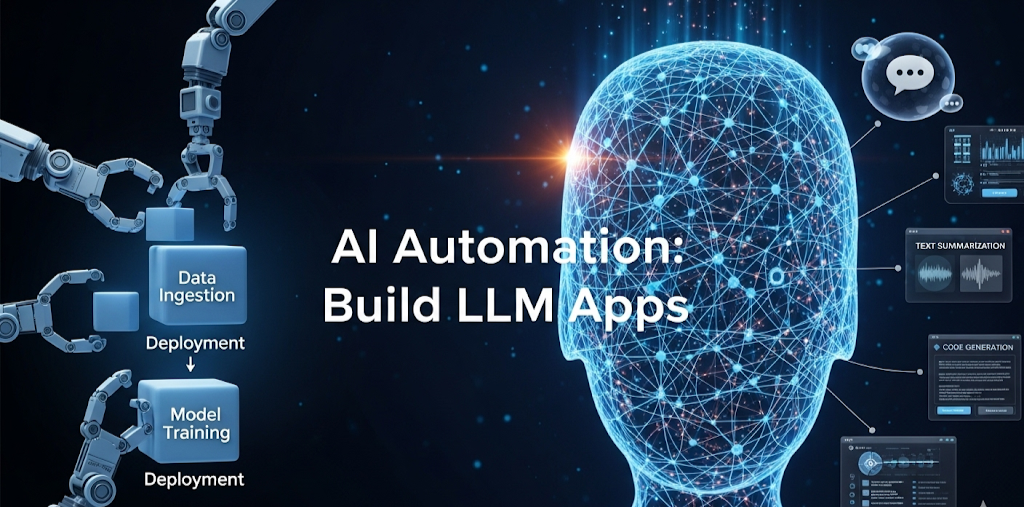In the world of technology today, artificial intelligence (AI) is revolutionizing industries across the globe. One of the most exciting and impactful applications of AI is in the realm of automation. AI automation is transforming the way we handle repetitive tasks, improve customer service, generate content, and much more. Among the many applications of AI automation, building LLM (Large Language Model) apps stands out as a game-changer.
But what exactly are LLM apps, and why are they so important?
AI automation refers to the use of AI systems to take over tasks that were previously done by humans. From answering customer queries to generating reports, AI can now complete tasks with speed, accuracy, and efficiency. When it comes to LLM apps, these are applications powered by large language models—AI systems trained on vast amounts of text data to understand and generate human-like language. They have the ability to create text, understand sentiment, translate languages, and even engage in natural conversations, making them extremely useful for various purposes.
In this article, we’ll dive into the process of building LLM apps and how AI automation can simplify development and improve functionality.
Step 1: Understanding the Basics of LLMs
Before building LLM apps, it’s essential to understand how LLMs work.
How do LLMs work?
LLMs use deep learning techniques, which involve training algorithms on large datasets of text. These models learn from the text patterns, structure, grammar, and context, making them capable of generating human-like text based on the input they receive.
For example, models like GPT (Generative Pretrained Transformer) and BERT (Bidirectional Encoder Representations from Transformers) are pre-trained on vast datasets and are fine-tuned to handle a wide variety of tasks. Whether it’s answering questions, summarizing content, or generating creative writing, these models are designed to perform exceptionally well across multiple use cases.
Common Applications of LLMs:
-
Text generation: Creating blog posts, articles, and even books.
-
Chatbots: Providing automated customer support in real-time.
-
Sentiment analysis: Determining the sentiment (positive, negative, neutral) of customer feedback.
-
Language translation: Translating text from one language to another.
Understanding the power of LLMs is key to building applications that can utilize their full potential.
Step 2: Key Tools and Frameworks for Building LLM Apps
Now that we understand the basics of LLMs, let’s look at some key tools and frameworks that help developers build LLM apps effectively.
LangChain:
LangChain is an open-source framework specifically designed for building LLM-powered applications. It provides developers with a set of tools to easily integrate LLMs with data sources, APIs, and external systems. It’s a great way to automate tasks like content creation, chat interactions, and more.
Hugging Face:
Hugging Face is a popular platform that offers a large repository of pre-trained models for various NLP (Natural Language Processing) tasks. With Hugging Face, developers can fine-tune existing models to suit their needs or use the pre-trained models for quick deployment.
OpenAI API:
OpenAI’s API gives developers access to powerful models like GPT-3 and GPT-4, allowing them to build sophisticated LLM apps. It’s a great resource for creating apps that involve text generation, question answering, and summarization.
TensorFlow and PyTorch:
These are two of the most widely used frameworks for deep learning. Both support the training and deployment of LLMs, providing a robust environment for building custom language models and fine-tuning them for specific tasks.
With these tools, developers have access to the necessary resources to build and deploy LLM apps quickly and efficiently.
Step 3: Building Your First LLM Application
Ready to build your own LLM app? Here’s a simple guide to get started.
Define the Purpose:
The first step is to decide the purpose of your LLM app. Ask yourself:
-
What problem does the app solve?
-
Who is the target audience?
-
What specific task will the app automate?
Whether it’s a chatbot for customer service, a text generator for blog posts, or a sentiment analyzer, defining the purpose will guide the development process.
Set Up the Environment:
To begin building your app, you’ll need to install some libraries. For example:
-
Install LangChain or Hugging Face to work with pre-trained models.
-
Set up the OpenAI API to interact with GPT-3 or GPT-4 models.
-
Install TensorFlow or PyTorch if you plan to train your own models.
Ensure your environment is ready and your tools are set up before moving forward.
Data Collection and Preprocessing:
LLM apps require data to function effectively. For a text generation app, you’ll need a large corpus of text relevant to your app’s purpose. Clean the data by removing irrelevant or noisy content. Then, tokenize the text so that the model can process it.
Model Training or Fine-Tuning:
If you’re working with a pre-trained model, you may want to fine-tune it to suit your specific needs. For example, if you’re building a customer service chatbot, fine-tune your model with a dataset of customer inquiries and responses.
Integrating the Model with Your Application:
Once the model is ready, integrate it with your application’s front-end. This could be a web interface where users interact with the app, or it could be an API that receives input and returns generated text.
Step 4: Advanced Features for LLM Apps
Once you’ve built the basic version of your LLM app, you can enhance its functionality with some advanced features.
Personalization:
Make the app more user-centric by personalizing responses based on previous interactions. For instance, chatbots can remember user preferences or tailor their responses accordingly.
Multimodal Capabilities:
Integrate other forms of AI like speech recognition, image generation, or even video processing to make your app more versatile. For example, a text-to-speech app can use LLMs to generate text and then convert it into audio.
Real-time Adaptability:
Ensure your app can learn and adapt based on user interactions. For example, a chatbot can improve its responses based on feedback from users, gradually becoming more accurate and helpful over time.
Step 5: Challenges and Best Practices
Building LLM apps comes with its own set of challenges, but by being aware of them, you can avoid pitfalls and create better applications.
Challenges:
-
Data Quality: LLMs require large amounts of high-quality data for effective training. Poor quality data can lead to biased or inaccurate results.
-
Computational Resources: Training LLMs requires powerful hardware and can be expensive, especially when dealing with large datasets.
-
Bias in Models: LLMs can inherit biases from the data they are trained on. It’s important to regularly audit and evaluate your models to reduce bias.
Best Practices:
-
Data Privacy: Always ensure your data is handled securely, especially when dealing with sensitive information.
-
Regular Evaluation: Continuously test your LLM app’s performance and make improvements as needed.
-
User Feedback: Take feedback seriously and use it to refine your app, making it more useful and responsive to user needs.
Conclusion
The future of AI automation, particularly in LLM apps, is incredibly promising. As the technology evolves, the potential for AI to automate tasks across industries continues to expand. Whether you’re a developer looking to build your first LLM app or a business aiming to incorporate AI-driven solutions, the tools and resources are available to get started.
Call to Action
Start exploring the world of LLM apps today! Experiment with the tools, dive into the frameworks, and begin building your own AI-powered applications. Whether you’re aiming to automate customer service, generate content, or analyze data, AI is here to help streamline your processes and deliver exceptional results.
FAQs
What is AI automation: build LLM apps and how does it work?
AI automation: build LLM apps involves using artificial intelligence to create language model applications that automate tasks like content generation, chatbots, and data analysis, improving efficiency and user experience.
What are the benefits of AI automation: build LLM apps for businesses?
By building LLM apps through AI automation, businesses can reduce manual workload, streamline operations, enhance customer interactions, and improve scalability without sacrificing quality.
Which tools and frameworks are best for AI automation: build LLM apps?
Popular tools for AI automation: build LLM apps include LangChain, Hugging Face, OpenAI API, and TensorFlow, which provide robust environments for building and deploying language model applications.
How can AI automation: build LLM apps enhance customer service?
AI-powered LLM apps like chatbots can offer 24/7 customer support, answer FAQs, handle complaints, and personalize responses, significantly improving customer satisfaction and reducing response time.
What are the challenges of AI automation: build LLM apps and how can they be overcome?
Challenges in AI automation: building LLM apps include data quality, model bias, and computational costs, but these can be overcome by using clean datasets, continuous evaluation, and leveraging cloud-based solutions for scalable resources.








Leave a Reply